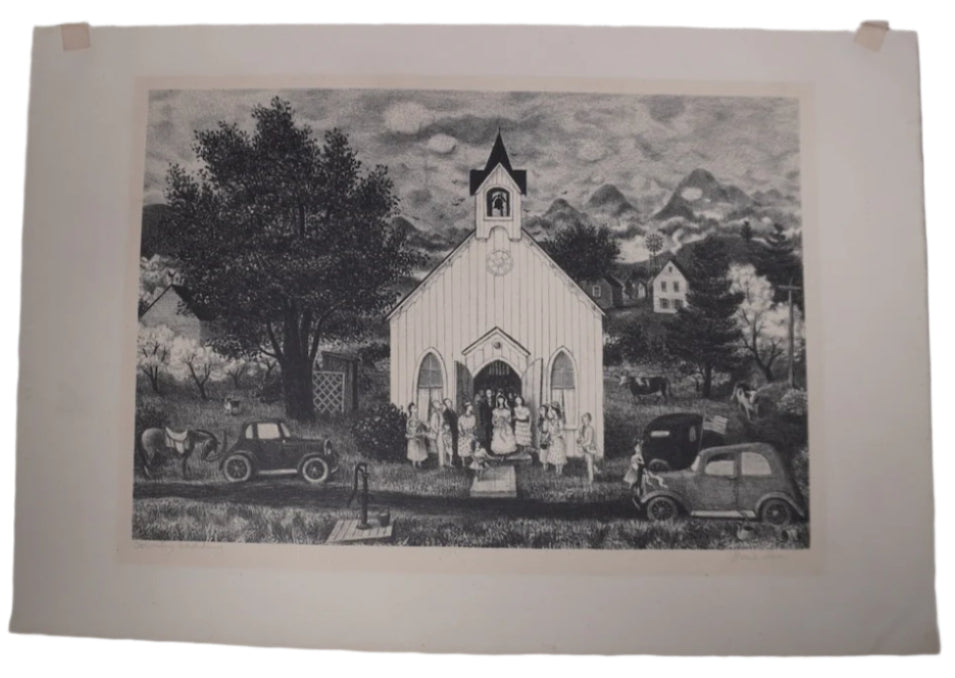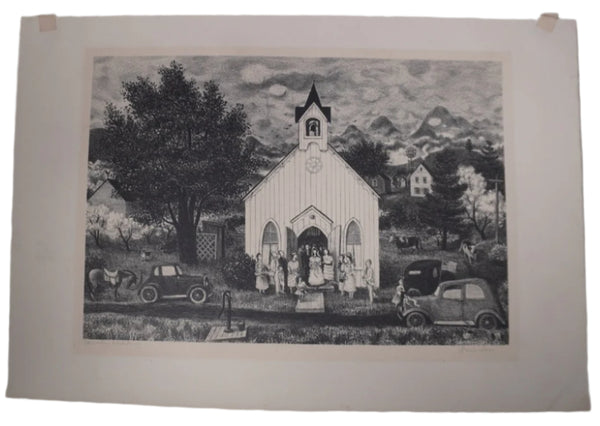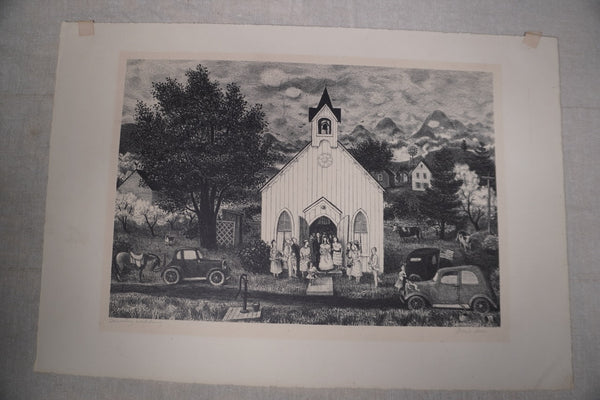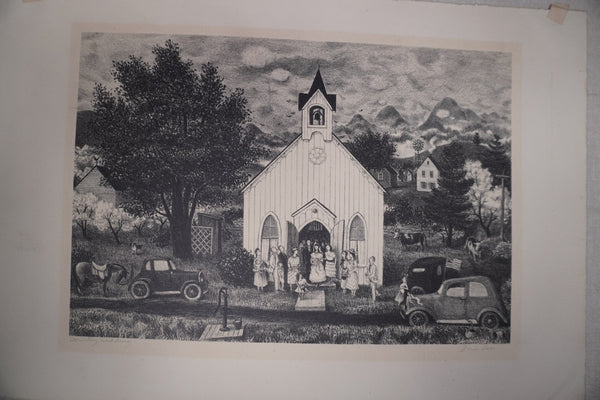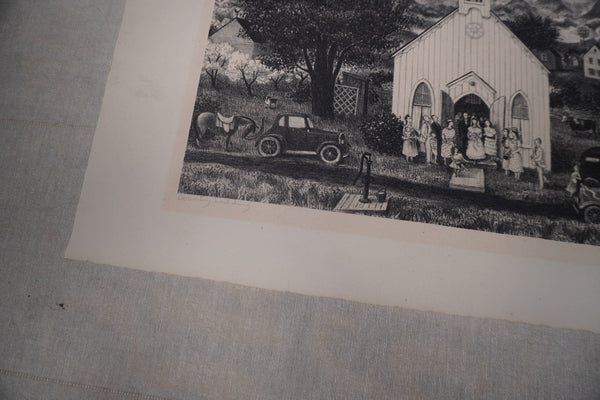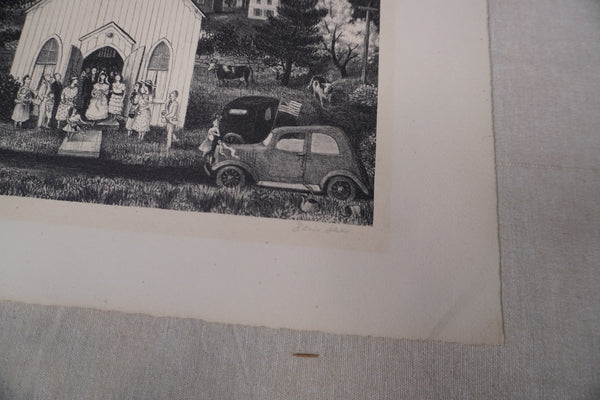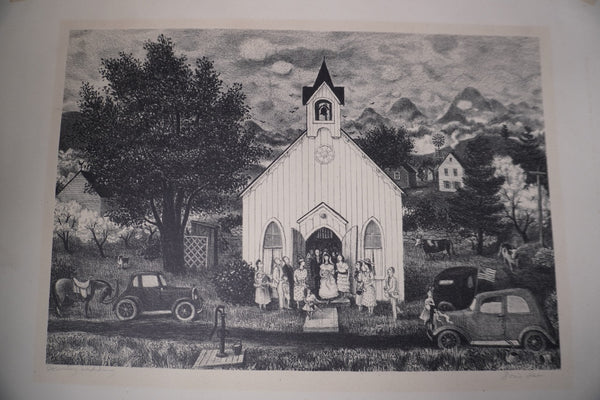Doris Lee (1904-1983) - Country Wedding - Etching 1943 AP1948
An absolute charmer. Associated American Artists, publisher, from her 1942 painting. image is 8" x 12" on an 11" x 16 1/2" sheet.
Doris Lee, born in Aledo, Illinois, was one of the most successful artists of the Depression era. Lee studied at the Kansas City Art Institute with the noted American Impressionist Ernest Lawson. She also studied in Paris with the influential cubist painter André Lhote and at the California School of Fine Arts, San Francisco, with Arnold Blanch, whom she later married. In 1931 Lee moved permanently to Woodstock, New York, and established herself as a leader in that important artist colony. The town's close proximity to New York City guaranteed a regular flow of artists between the colony and the metropolis, keeping in touch with current developments in the arts. The Art Students League of New York helped to create that flow when it established a summer school in Woodstock in 1906 that brought hundreds of art students into the town each summer.
The 1930s marked the beginning of a long and productive career for Doris Lee. Her work included easel paintings, murals, prints and illustrations, as well as costume, textile and ceramic design. Lee's work from this period was concerned with life in rural America, and in a stylistic and ideological sense, has much in common with Regionalism. Lee portrayed the simple joys of American life in touching, nostalgic and sometimes fanciful ways. Lee's work was exhibited in the first Whitney Biennial exhibition in 1931. In 1932 the Rhode Island School of Design acquired April Storm. Her earliest major career achievement came in 1935 when she was awarded the Logan Prize for her painting Thanksgiving from the Art Institute of Chicago. The painting, a view of a farm kitchen full of "bustle and bounce and sly humor," was subsequently purchased by the Institute. Shortly after the Logan Prize, Lee was awarded two commissions by the U.S. Department of the Treasury for murals for the Washington, D.C. Post Office Building. An additional boost to the artist's fame and prestige came in 1937 with the purchase of her painting Catastrophe by the Metropolitan Museum of Art. From 1938 to 1941, Doris Lee was invited to be a summer guest artist at the Colorado Springs Fine Art Center. The 1930s finished with a flourish when Lee was invited to exhibit in the 1939 New York World's Fair. This early support given Lee by museums and the art establishment was an impressive accomplishment for a young woman struggling for acceptance in the male-dominated art world of the time.
Starting in the late 1930s, Doris Lee and her husband, Arnold Blanch, began to spend their winters in Key West, Florida. During the winters of the 1940s into the 1960s Lee painted her unique Florida subjects: fishermen, bathers, beaches, mangrove swamps, and Florida's plants and wildlife. Lee combined the sophistication of her knowledge of pure abstraction with her love of American folk art to create her unique style.
In the 1940s Lee's work became more stylized, more concerned with pure form and color. Her simple, flat paintings portrayed gardens, seasonal landscapes, and women and children, as well as birds and beasts. In 1943 and 1944 Lee was guest artist at Michigan State College in Lansing, Michigan. She was awarded the prestigious Carnegie Prize in 1944 and was included in fifteen of the annual juried exhibitions at the Pennsylvania Academy of the Fine Arts. Lee received many painting assignments from Life magazine during these years. She worked in Hollywood, California and Hawaii during the winter months of 1945 and toured Central America in 1946 and North Africa in 1951 for Life Magazine assignments.
Doris Lee's dealers were Associated American Artists Gallery and World House Galleries in New York City, the Maynard Walker Art Gallery (1936-1950), and Rudolf Gallery in Woodstock. She participated in both one-man and group exhibitions with these dealers.
Doris Lee retired from painting in the 1960s. She died in Clearwater, Florida in 1983. In addition to the Art Institute of Chicago, the Rhode Island School of Design, and the Metropolitan Museum of Art, Lee's work can be found in many public collections, including the Whitney Museum of American Art, Phillips Collection, Washington, D.C., Cleveland Museum of Art, Pennsylvania Academy of the Fine Arts, National Museum of Women in the Arts, and the Greenville County Museum of Art, Greenville, SC.
Memberships
American Artists Congress; An American Group; National Association of Women Artists; Society of Painters, Sculptors, and Gravers; Woodstock Artists Association (president, 1952)

